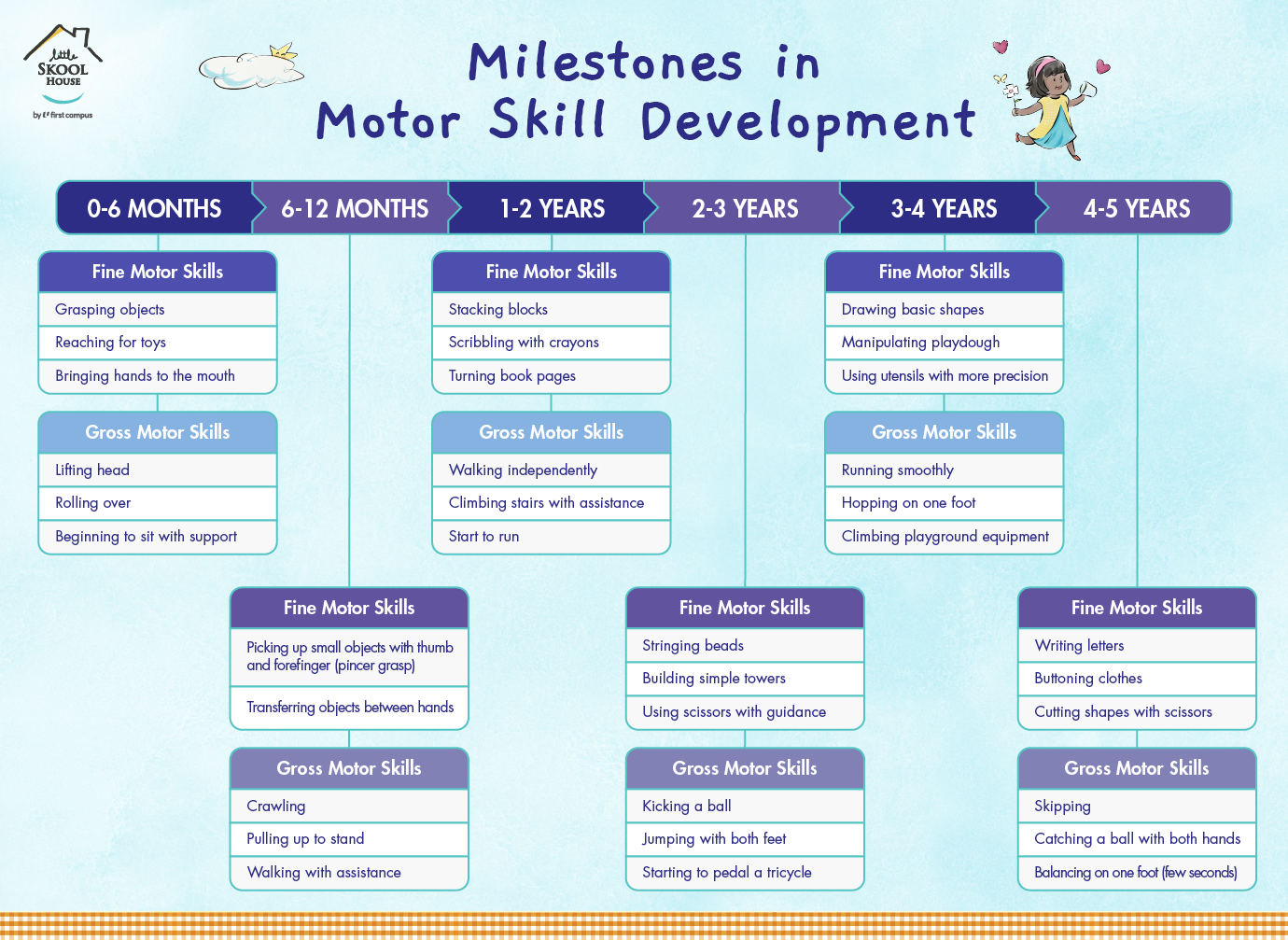BACK
Table of Contents
- Understanding Fine and Gross Motor Skills
- Key Differences Between Fine and Gross Motor Skills
- Milestones in Motor Skill Development
- How Motor Skills Impact Daily Life and Learning
- 6 Activities to Develop Motor Skills at Home
- Fine and Gross Motor Skills Development Beyond Home
In this guide, we’ll explore the key differences between fine and gross motor skills, the milestones children typically reach as they grow, and how these skills influence everyday tasks and learning.
Whether you’re looking to understand your child’s progress or find fun activities to enhance their skills—at home or through trusted preschools like Little Skool-House—this article offers valuable insights to guide you through their developmental journey.
Understanding Fine and Gross Motor Skills
Motor skills are essential to a child’s physical development, affecting how they move, play, and interact with the world. These skills are divided into fine and gross motor skills, and understanding the differences helps support your child’s growth at each stage.
What are Fine Motor Skills?
Fine motor skills involve the small muscles in the hands, fingers, and wrists. These skills are crucial for tasks that require precision, such as holding a pencil, fastening buttons, or stacking blocks. They play a vital role in activities like drawing, cutting with scissors, and turning pages in a book.
When children practice fine motor tasks, they not only strengthen their physical abilities but also enhance their cognitive development and problem-solving skills.
What are Gross Motor Skills?
Gross motor skills involve the large muscles in the arms, legs, and torso, enabling children to perform big movements like running, jumping, and climbing. These gross motor movements are essential for overall physical development.
Mastering gross motor skills is vital for physical health, confidence, and independence. Activities like climbing stairs and running help strengthen leg muscles, which are crucial for balance and coordination.
Key Differences Between Fine and Gross Motor Skills
While both fine and gross motor skills are essential for a child’s development, they differ in several key areas:
| Aspect | Fine Motor Skills | Gross Motor Skills |
| Muscle Groups Involved | Small muscles in the hands and fingers. | Large muscles in the arms, legs, and core. |
| Examples of Activities | Writing, buttoning, drawing, and stacking blocks. | Running, jumping, climbing, and throwing. |
| Precision vs. Power | Focuses on precision, careful control, and hand-eye coordination. These precise actions are essential for tasks like writing and buttoning clothes. | Emphasises strength, coordination, and fluid, powerful movements. Coordinated movements are crucial for activities like running and jumping. |
| Developmental Timeline | Develops slightly later; more refined in early preschool years. | Develops earlier; infants often master gross movements first. |
| Sensory Integration | Helps with tasks that require careful manipulation and focus. | Supports balance, coordination, and exploration through movement. |
| Connection Between Skills | Often paired with gross motor tasks for complete activities (e.g., catching and holding a ball). | Provides the foundational strength and coordination for fine motor tasks. |
Milestones in Motor Skill Development

Children achieve motor skill milestones at different ages, but there are typical ranges where certain abilities emerge. These developmental milestones are crucial indicators of a child’s growth and progress.
Fine Motor Skills Milestones in Children
- 0–6 months
- Grasping objects
- Reaching for toys
- Bringing hands to the mouth
- 6–12 months
- Picking up small objects with thumb and forefinger (pincer grasp)
- Transferring objects between hands
- 1–2 years
- Stacking blocks
- Scribbling with crayons
- Turning book pages
- 2–3 years
- Stringing beads
- Building simple towers
- Using scissors with guidance
- 3–4 years
- Drawing basic shapes
- Manipulating playdough
- Using utensils with more precision
- 4–5 years
- Writing letters
- Buttoning clothes
- Cutting shapes with scissors
Gross Motor Skills Milestones in Children
- 0–6 months
- Lifting head
- Rolling over
- Beginning to sit with support
- 6–12 months
- Crawling
- Pulling up to stand
- Walking with assistance.
- 1–2 years
- Walking independently
- Climbing stairs with assistance
- Start to run
- 2–3 years
- Kicking a ball
- Jumping with both feet
- Starting to pedal a tricycle
- 3–4 years
- Running smoothly
- Hopping on one foot
- Climbing playground equipment confidently
- 4–5 years
- Skipping
- Catching a ball with both hands
- Balancing on one foot for a few seconds
Signs of Delayed Development
While children progress at different rates, certain signs may indicate developmental delays in motor skills. Developmental coordination disorder (DCD) is one such condition that can affect a child’s ability to perform everyday tasks.
Fine Motor Delays:
- Difficulty grasping small objects or using utensils.
- Struggling to stack blocks or manipulate toys.
- Trouble with basic tasks like buttoning clothes or holding a crayon.
Gross Motor Delays:
- Inability to sit up, crawl, or walk within typical age ranges.
- Difficulty with balance, coordination, or climbing stairs.
- Avoidance of active play, like running or jumping.
If these signs persist beyond typical age ranges, it may be helpful to consult with a paediatrician or early childhood specialist for assessment and guidance.
How Motor Skills Impact Daily Life and Learning
Motor skills are not just about physical movement; they play a crucial role in a child’s ability to perform everyday tasks and engage in learning experiences.
Mastery of both fine and gross motor skills enables children to navigate their environment confidently, participate in classroom activities, and complete daily routines independently.
Fine Motor Skills in Daily Tasks
Fine motor skills are essential for many practical tasks children encounter every day. These skills involve precise actions that require intricate hand-eye coordination and control:
- Handwriting. Learning to hold a pencil correctly, form letters, and write legibly all depend on fine motor control. Children who struggle with these skills may find classroom activities more challenging.
- Eating and Dressing. Skills like using utensils, fastening buttons, and tying shoelaces require precise hand movements and coordination. Mastery of these tasks boosts independence and self-confidence.
Gross Motor Skills and Active Play
Gross motor skills are foundational for active play and physical development. Reaction time is also a critical component of these skills, allowing children to respond quickly and effectively during physical activities:
- Running, Jumping, and Balance. Activities that involve running, hopping, and balancing help children develop muscle strength, coordination, and spatial awareness.
- Playground Activities and Physical Coordination. Climbing, swinging, and sliding on playground equipment promote confidence and physical fitness while building core strength and stability.
Both fine and gross motor skills contribute significantly to a child’s overall development, influencing how they explore, learn, and engage with the world around them.
6 Activities to Develop Motor Skills at Home
Children’s motor skills can be nurtured through fun, engaging activities that fit seamlessly into daily routines.
These activities provide opportunities for children to practice and develop new skills, enhancing their overall physical and cognitive development:
3 Activities to Enhance Fine Motor Skills
- Playdough Adventures. Manipulating playdough is an excellent way for children to strengthen their hand muscles and improve dexterity. Introducing a colourful toy can make the activity more engaging and visually stimulating for children. Encourage them to roll, pinch, and mould shapes—this builds coordination and finger strength while sparking creativity.
- Scissor Skills Mastery. Cutting paper with safety scissors helps refine hand-eye coordination and control. Start with simple straight lines and gradually progress to curves and shapes as your child gains confidence.
- Block Building Marvels. Stacking blocks of different sizes improves precision and spatial awareness. Challenge your child to build towers or recreate simple structures to boost their fine motor control.
3 Activities to Boost Gross Motor Skills
- Colourful Ball Play. Kicking, throwing, and catching balls help children develop hand-eye coordination and core strength. Vary the size of the balls to challenge different skill levels.
- Nature’s Outdoor Canvas. Exploring nature—running on grass, climbing small hills, or balancing on playground beams—enhances balance and muscle control. Ensuring a safe environment for these activities is crucial to prevent injuries and promote confident exploration. Outdoor play also encourages sensory exploration.
- Dance, Jump, and Climb. Turn on some music and encourage your child to dance, jump, and climb. These activities build leg strength, rhythm, and overall body coordination.
Fostering motor skills at home doesn’t require special equipment—just creativity, time, and space to explore and play.
Fine and Gross Motor Skills Development Beyond Home
Fine and gross motor skills are vital to a child’s growth, influencing their ability to learn, play, and engage with the world.
While these skills are nurtured at home, their development is greatly enhanced in the classroom, especially at Little Skool House. Through purposeful play, hands-on activities, and expert guidance, we create a supportive, premium preschool environment where children can refine their abilities.
By fostering motor skills in a balanced and engaging setting, we help children build the foundation for independence, confidence, and lifelong learning.
At Little Skool House, we ensure that every child has the opportunity to explore, grow, and thrive, preparing them for success in all aspects of life.
Choose from 20 Conveniently-Located Centres
Discover the Little Skool-House Difference
Register Now for a Journey of Learning and Growth.
- Award-winning teachers
- Proven bilingual curriculum
- Trusted by parents across Singapore
Limited slots available. Secure your child’s place today.



